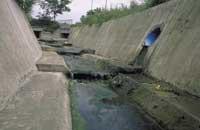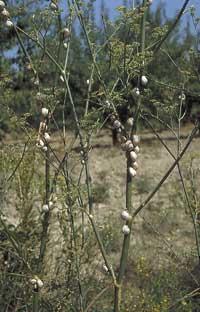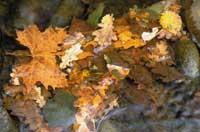Pain in the meanders
2004/02/01 Lakar Iraizoz, Oihane - Elhuyar Zientzia | Izagirre Igartua, Oihana Iturria: Elhuyar aldizkaria
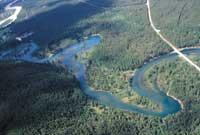
The producers (algae and plants), through photosynthesis, produce oxygen and organic matter from inorganic nutrients in the water (nitrates, nitrites, phosphates…). In this way, rivers are purified, mainly because they retain nutrients that reach the water by human action. In addition to their own production in the water, the rivers receive organic matter from the outside, especially in the streams surrounded by riverside forests, in autumn, with the fall of the litter. Orbela is the main source of food for many consumers, including invertebrates, fungi and bacteria. All of them process the organic matter that reaches the river and are also the main food of the fish. In addition to fish, in the rivers there are mammals, amphibians and birds that form a complex network of pastures.
These ecosystems have a great importance for people, since, in addition to their aesthetic and romantic values, they offer different resources: water, energy, transport, fish, landscape, leisure areas, self-purification capacity... However, the rise of the human population and the advancement of technology have seriously affected rivers. All wastewater, from domestic wastewater to industrial cyanide spills, has been poured directly into the river, eliminating riparian forests and affecting riverbed morphology. All this influences the structure and functions of the ecosystem, so rivers are not in the best conditions, although in many cases they have improved in recent years.
We have recently realized the need to deal with this situation, since in its day no attention was paid to environmental problems. Research on river ecosystems, quality monitoring and sanitation plans, among others, have been developed to recover healthy ecosystems.
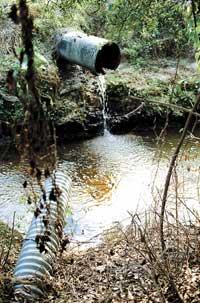
Initially, water analysis was carried out exclusively for the study of water quality. However, these analyses are often unable to detect hundreds of pollutants at once in water, much less in rivers. In fact, discharges in rivers can only be measured in a short period of time, as it drags them quickly down. Soon after the spill the water may become clean, but the river is already damaged. Biotic indexes were developed to detect the damage caused by this type of spills. Through them, biological communities are analyzed to know the history of water quality. If a periodic spill occurs, the most sensitive beings disappear, detecting it we can suspect that there has been some problem in the water. Over time different biotic indices have been developed, the most common being those based on invertebrates and algae.
But what is a healthy river?
Health is the situation in which the organic being properly fulfills all its functions. Therefore, we can say that an ecosystem is healthy if it properly fulfills all its functions. Of course, proper structures are needed for proper functioning. For example, photosynthesis cannot occur if there is no vegetation. Ecological integrity therefore requires a structural whole and a functional whole, since they are the two sides of the same coin. The physical structure of the ecosystem consists of biological communities and their resources, analyzing their quantity and quality. When defining functionality, different processes are analyzed at the ecosystem level. When the quality of these two components is good, we can say that the river is healthy.
However, any change in rivers does not necessarily affect structure or functions. For example, an experiment conducted on the Australian Mary River showed that increased nitrogen and water turbidity did not affect the invertebrate community (structure), but caused changes in respiration and primary production (functions). This requires taking into account both components, structure and function when analyzing the health of rivers.
In order to measure the health of an ecosystem it is necessary to compare it with an optimal situation. For this, reference systems can be used, that is, rivers still in ‘natural’ state. It is always necessary to keep in mind that the rivers are very different from one place to another because of variables such as climate, geology, etc., so a river and its referent must have similar conditions. In reference rivers we can study the physical-chemical characteristics, the structure of biological communities and various functions of the ecosystem, values that would be obtained when recovering affected rivers.
What does the law say about it?
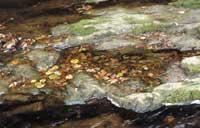
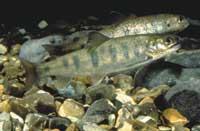
Water quality policy is changing very deeply. To date, according to the Spanish Water Law of 1999, pollution was defined as a deterioration of the chemical composition of water and the degree of pollution was determined by measuring the concentrations of different chemicals in water. On the other hand, the quality to be achieved was different depending on the use of water (irrigation, drink, fish conservation, etc. ). Now, however, the Water Directive of the European Union states that to measure the quality of the water masses its chemical and ecological status must be measured. This new concept defines ecological status as the expression of the quality of the structure and functioning of aquatic ecosystems. Water quality includes physical-chemical quality, biological quality and hydromorphological quality (riverbed structure). Moreover, it does not depend on its use but on its fulfillment in all the water masses.
It proposes a series of indicators that allow to measure the quality, according to which the ecological state of the waters can be very good, good, acceptable, deficient or bad. To do this, the reference points should be selected, that is, the rivers or streams that have suffered a poor human condition and analyze the values of the indicators. Water masses with similar values will be considered to have a very good ecological state, and the further away from these values, the worse the ecological state will be.
As can be seen, the Water Directive makes it quite clear to what extent the ecological status of aquatic ecosystems should be measured. And if this were not enough, it also sets the following goal: By 2015, the ecological status of all surface water bodies in the European Union should be good for all indicators (excluding exceptions and moratoriums). All this will require immense research, work, fortune and political will that some consider too ambitious.
However, although the Directive begins to look for gaps, it makes clear in its definitions and intentions how important the functioning of aquatic ecosystems is, when mentioning biological methods of quality measurement, it proposes only those that define the structure (algae, invertebrates, fish), and does not refer to function analysis instruments. In fact, standard tools have not yet been developed to measure the functioning of rivers around the world, although this is essential for ecological quality. Aware of this lack, several researchers are seriously working on the development of these new tools.
New instruments for the study of river health: function analysis
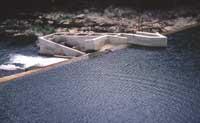
In recent times, the work on tools for the study of the functions of river ecosystems is in full force, and the most outstanding works of the congresses are focused on this topic.
Nutrient purification, retention and use of the litter, migrations of living things, fish production, metabolism, etc. There are methods to measure all these functions, but each researcher continues to use them differently, and water management administrations or entities need standard tools and, above all, reference values to interpret the results. In each type of river, the values that these processes should have should be defined, as well as the measures that should be taken if they are affected, this being the objective at this time of several research projects.
At the University of the Basque Country/Euskal Herriko Unibertsitatea, the River Ecology Laboratory has two projects in this field: one around the use of the litter (RIVFUNCTION) and the other around metabolism (METATOOL).
At RIVFUNCTION, 10 universities across Europe are working on the influence of eutrophication (nutrient proliferation) and degradation of riparian forests in the decomposition of the litter. The decomposition, called degradation of organic matter, reflects the capacity of the river to use the material that comes to it. When the orbela reaches the river, invertebrates and microorganisms (fungi and bacteria) use it and break it down.
The decomposition capacity of the litter, in addition to being an important function in the streams, is very sensitive to different stresses. To measure this capacity are placed mesh bags full of leaf litter in the river. Two types of bags are used: one of thick net that allows the entry of all invertebrates and microbes, and another of fine mesh that prevents the entry of invertebrates. In this way, bags can be collected on a temporary basis, measuring the amount of the remaining litter and measuring the influence of invertebrates and microbes on the decomposition of the litter.
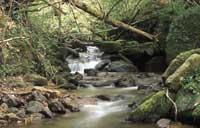
The University of the Basque Country has been able to detect the dysfunction of rivers with an excess of inorganic nutrients in which the microbial influence has increased considerably. On the other hand, it has been proven that the decomposition of the litter in the rivers surrounded by eucalyptus is slower than in those surrounded by natural riparian forests, in which case invertebrates are responsible. The results obtained in this project will allow us to have a new tool for analyzing the health of the rivers.
The METATOOL project focuses on the metabolism of the entire river. In rivers the metabolism is divided into two parts: primary production and breathing. Oxygen consumption occurs throughout the day, due to the breathing of producers and consumers, but in daylight algae produce organic matter and oxygen. Thus, according to the balance of production and breathing rates, the oxygen concentration of the water is changing.
The excess of nutrients and light on the channel causes an increase in primary producers and a concentration of oxygen during the very high day. This organic material, however, accumulates and rots, which consumes a lot of oxygen, greatly reducing the oxygen concentration during the night. These deficiencies are very dangerous for living beings in the river; for example, salmon need oxygen concentrations higher than 6 mg/l and trout higher than 4 mg/l. All this can affect the river.
But research into metabolism has difficulties. The methodology requires measuring oxygen concentration and temperature over time, so automation is necessary. In the CAPV, in the rivers of Gipuzkoa and Bizkaia, the Provincial Councils have 21 hydrometeorological stations that measure oxygen and temperature every 10 minutes. The UPV/EHU River Ecology Laboratory, given the possibility of using data obtained through this infrastructure, addressed this metabolic project. In addition to the calculation of primary production and respiratory rates through the production of oxygen data, algae sampling has been carried out in order to analyze its biomass and the composition of the community. In this way, it is intended to analyze the relationship between metabolism and primary producers with the characteristics of rivers and create a new tool to analyze in real time the functioning of rivers. This would serve, among other things, to measure the ecosystem response at the time a spill occurs.
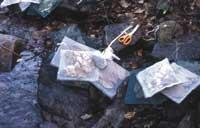
For example, the summer of 2003 has been very warm and dry, so primary production has been very high and huge amounts of algae have developed in the most eutrophic seasons. As a result, oxygen concentrations have experienced large fluctuations throughout the day. In the case of cleaner stations, oxygen concentrations have remained high, a sign of good river health, as well as stations with very low oxygen concentrations due to high pollution.
In addition to decomposition and metabolism, it is expected that through the research being carried out worldwide on many other functions, appropriate tools are developed for the analysis of them. These instruments will be in the hands of administrations and water managers within a few years and will enable deeper studies of river health. If we achieve the objectives of the new Water Directive and with these new tools, our descendants have healthier rivers.



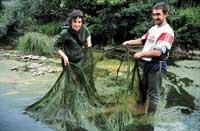

Ecological status indicators proposed in the new European Water Directive
- Biological indicators:
- Composition and abundance of aquatic flora
- Composition and abundance of aquatic invertebrates
- Composition, abundance and age distribution of fish
- Hydromorphological indicators with incidence in biological indicators:
- Hydrological regime
- Flow hydrodynamics or water flow
- Links with groundwater masses
- Continuity of the river
- Morphological characteristics
- Depth and width of the river
- Structure and composition of the river bottom substrate
- Structure of the valleys
- Hydrological regime
- Physico-chemical indicators affecting biological indicators:
- General
- Temperature
- Oxygen
- Salinity
- Acidification
- Nutrients
- Specific contaminants
- Pollution caused by all priority pollutants discharged into the water.
- Contamination caused by all substances that have been poured into water in significant amounts.
- General
In the Basque Country, aware of the problems of water pollution, in the late 1970s, the administration began to conduct studies of characterization and use of water. However, because of studies that developed in the face of specific pollution problems, their approach was reduced. The first work from a broader perspective was the physical-chemical characterization of CAPV river waters in 1984. The Provincial Council of Bizkaia, led by the Provincial Council of Bizkaia, began in 1985 the first extensive research that took into account the physical-chemical and biological characteristics. The study analyzed the diversity, abundance and prevalence of macrophytes, riverside forest vegetation, invertebrates and fish. In addition, several biotic indexes of invertebrates were applied. In order to extend this research to the entire ACBC in 1989, the Vice-Ministry of the Environment requested a new study in Álava and Gipuzkoa (Basque Government, 1992). In recent years, in 82 points of the rivers of the CAPV physical-chemical, biological and morphological analyses are performed. Initially, only biotic indices of benthic invertebrates and fish censuses were performed among biological analyses. Algae are now also analyzed. Hydromorphologically, the structure of the riparian forests is analyzed. In some stations, in addition, every 10 minutes are measured automatically different physical-chemical parameters (flow rate, temperature, dissolved oxygen, pH, ammonia, etc. ). Our rivers remain far from the quality required by the European Water Directive, since, in addition to the physical-chemical and community problems, the riverside structure is very poor. The canalizations are numerous, there are many rivers that are limited between two walls. The riverside forests are very scarce and the existing ones are structurally poor. This impacts the health of river ecosystems. |
BIBLIOGRAPHY
- EUROPEAN PARLIAMENT Directive
2000/60/EC of the European Parliament and of the Council of 3 October 2000 (date of consultation: 20 October 2003). 2000. http://europa.eu.int/eurlex/pri/es/oj/dat/2000/l_327/l_32720001 222es00010072.pdf . - Boulton, A.J.
“An overview of river health assessment: philosophies, practice, problems and prognosis” Freshwater Biology, 41: 469-479. 1999 - Gessner, M.O. Chauvet, E.
“A case for litter breakdown to asses functional stream integrity” Ecological Applications, 12(2): 498-510. 2002. - Uehlinger, U., König, C. Reichert, P.
Variability of photosynthesis-irradiance curves and ecosystem respiration in a small river. Freshwater Biology, 44:493-507. 2002. - Rallo, A.
- Basque Government, 1992.

Gai honi buruzko eduki gehiago
Elhuyarrek garatutako teknologia



